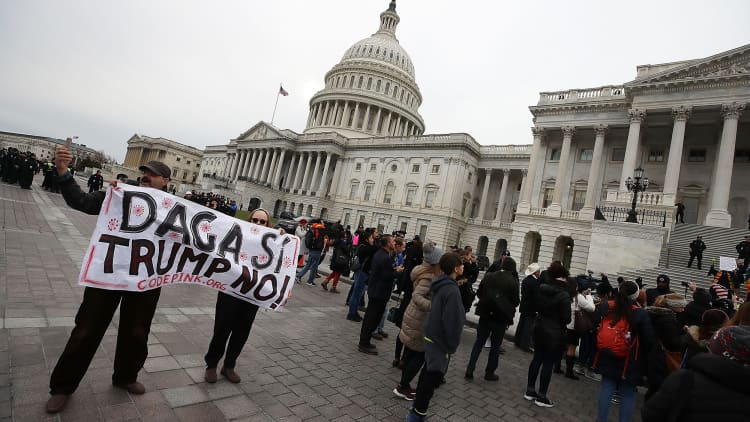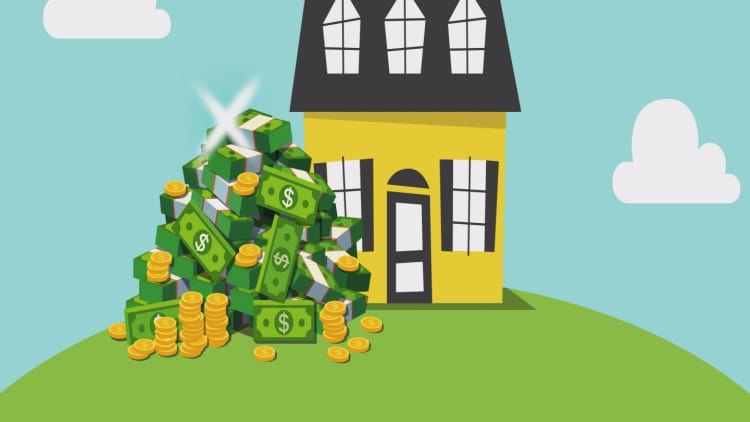
Two weeks into a partial government shutdown, hundreds of thousands of federal workers are furloughed or working without pay.
That's longer than most can get by without income, considering that over three-quarters of all full-time workers are living paycheck to paycheck, according to a report from CareerBuilder.
From personal loans to credit card advances, there are a number of ways to access cash to bridge the gap. But not all types of borrowing are created equal.
Here are some of the best and worst loans out there.
Payday loans
Also called cash advances, payday loans are the worst offenders. Even though these short-term loans, generally for $500 or less, are relatively easy to get — often through storefront payday lenders or even online — the interest can easily run into the triple digits.
Depending on your state's laws, payday loans are typically due two weeks later and must be paid off in one payment along with a "finance charge" (the service fees and interest).
Many states set a maximum amount for payday loan fees ranging from $10 to $30 for every $100 borrowed. But still, a two-week payday loan with a $15 per $100 fee is the equivalent of an annual percentage rate of almost 400 percent, according to the Consumer Financial Protection Bureau.
Tapping a 401(k)
Although many financial advisors also say 401(k) loans should be off-limits entirely, federal law allows workers to borrow up to 50 percent of their account balance, with a maximum of $50,000.
Borrowers then have up to five years to pay back their loan, which comes with an interest rate that typically is lower than with other borrowed money, such as credit card advances.
There is a significant downside to borrowing from your own retirement account, which is a permanent setback to your retirement planning.
Credit card cash advance
Credit cards are one of the most common — and also one of the most expensive — ways to borrow money. Currently, credit card rates are at a record high, at an average of about 17 percent, according to Bankrate. The rate on a credit card cash advance is even higher.
For example, the Chase Freedom card has an interest rate of 16.74 percent to 25.49 percent, depending on your creditworthiness, but the cash advance APR is a flat 26.74 percent, according to Ted Rossman, an industry analyst at CreditCards.com.
In addition, consumers must pay a transaction fee — which is usually 3 percent to 5 percent of the cash advance amount — as well as interest on the loan.
"The truth is that a credit card cash advance can be among the best of a bunch of bad options when times get really tough, and a situation like the government shutdown can certainly be one of those times," said Matt Schulz, chief industry analyst at CompareCards.com.
But before paying 30 percent interest or higher for a cash advance, "it's much smarter to make purchases with the credit card itself, rather than taking out a cash advance," added Ashley Dull, a credit strategist at CardRates.com.
Better yet, "consider taking a short-term loan from a credit union, where you can get much lower rates versus tapping into your personal line of credit," Dull said.
Personal loans
Personal loans, or unsecured loans, do not require borrowing against something of value, like a house, which makes them particularly attractive for those without that kind of equity. However, that generally means the loans come with a higher interest rate than a home equity loan.
Personal loans are also locked in over shorter terms, like one to five years, and payments are generally automatically deducted from a checking account, which decreases the odds of missing a payment or defaulting.
Personal loans are well suited for smaller loan amounts than a typical home equity loan, but more than one would want to run up on credit cards — generally, anything up to $35,000.
A number of online lenders, like Lending Club and Prosper, have popped up in recent years making these types of loans more accessible.
The average interest rate on an unsecured loan is currently about 11 percent, according to Bankrate, although those with very good credit can get a rate as low as 5.5 percent. That's notably less than the APR on a credit card.
Home equity
Before the Great Recession and the historic housing crash, homeowners used their homes to access as much cash as the bank would allow. But borrowers who were burned by falling housing prices, not to mention today's tighter lending standards, are considerably more wary now when it comes to home equity loans and lines of credit — despite the more favorable terms.
Still, the amount of equity today's homeowners are able to tap is at the highest level on record.

One of the most common ways to access that equity is through a cash-out refinance (which is when you refinance your current mortgage and take out a bigger mortgage) or a home equity loan.
A home equity loan can be withdrawn as a lump sum with a fixed rate and a repayment period generally of five to 15 years or as a home equity line of credit with a variable rate.
The average interest rate on a home equity loan is 5 percent to 6 percent but, under the new tax law, the interest is not tax-deductible unless the money is used to improve your home.
Government shutdown assistance programs
In some cases, financial institutions that cater to federal workers and members of the military are offering furlough relief loans to help affected workers stay afloat in the short term.
For example, the Congressional Federal Credit Union has a relief line of credit with an initial rate of 0 percent for 60 days. After that, the rate on the remaining balance is 4 percent.
The Navy Federal Credit Union is also offering loans of up to $6,000 at 0 percent with no fees and no credit check to federal government employees and contractors for 60 days or until any back pay is made, whichever comes first.
The Pentagon Federal Credit Union, known as PenFed, has a similar offer for its members impacted by the shutdown.
And the USAA, a financial services firm that specializes in customers with a military connection, is offering a one-time, 12-month personal loan with an interest rate of 0.01 percent. That offer is only available to eligible members who are in the Coast Guard or National Oceanic and Atmospheric Administration Corps and who have experienced an interruption in their federal pay.
Meanwhile, if your income is disrupted as a result of the shutdown and you've been hit with an overdraft or insufficient funds fee, some big banks, including Wells Fargo, Bank of America and Chase, are offering to waive those charges for now.
Further, mortgage, loan and credit consumers may qualify for forbearance or other payment assistance programs, depending on each individual's circumstances.
More from Personal Finance:
Wells Fargo, Bank of America offer help for clients hurt by the federal shutdown
How workers are hurting amid the government shutdown
What federal workers can do to generate some cash amid the government shutdown


